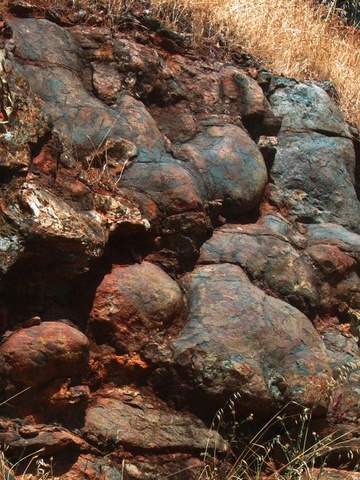 Pillow basalt in Timbuctoo. The billowing shape of these rocks indicates that they were formed by lava erupting under the ocean and being rapidly cooled by the ocean water. Lava that erupts on dry land flattens out before it solidifies. Photo by queerbychoice. The Smartville ophiolite is an ophiolite (a large expanse of rocks from the ocean floor exposed on the surace of dry land) that passes through much of the northern California foothills, reaching from northwestern Lake Oroville southeast to Cameron Park. Its western edge passes slightly east of Palermo and Loomis, and its eastern edge passes slightly east of Nevada City. In Yuba County, it passes through Browns Valley, Brownsville, Challenge, Dobbins, Frenchtown, Greenville, Loma Rica, Oregon House, Rackerby, the Spenceville State Wildlife Area, and of course the town of Smartsville, for which it is named.
Pillow basalt in Timbuctoo. The billowing shape of these rocks indicates that they were formed by lava erupting under the ocean and being rapidly cooled by the ocean water. Lava that erupts on dry land flattens out before it solidifies. Photo by queerbychoice. The Smartville ophiolite is an ophiolite (a large expanse of rocks from the ocean floor exposed on the surace of dry land) that passes through much of the northern California foothills, reaching from northwestern Lake Oroville southeast to Cameron Park. Its western edge passes slightly east of Palermo and Loomis, and its eastern edge passes slightly east of Nevada City. In Yuba County, it passes through Browns Valley, Brownsville, Challenge, Dobbins, Frenchtown, Greenville, Loma Rica, Oregon House, Rackerby, the Spenceville State Wildlife Area, and of course the town of Smartsville, for which it is named.
The theory of plate tectonics holds that the North American continental plate has been moving gradually west ever since North America broke away from the supercontinent Pangaea during the time of the dinosaurs. While moving west, the North American continental plate collided with several large prehistoric islands, which then became attached to the continent. Most of the land in California comes from these large prehistoric islands. In fact, the Mojave desert region is the only part of California that was originally part of the North American continental plate.
In a few areas, part of the ocean floor that had previously separated those prehistoric islands from the continent was pushed up and became part of the continental surface. These areas of former ocean floor are called ophiolites. The Smartville ophiolite is one of several major ophiolites in California.
Ophiolites are found in all the major mountain ranges of the world. The need to explain how fossils of prehistoric sea creatures ended up on high mountaintops played a major role in the development of the theory of plate tectonics. Additionally, much of what scientists know about the ocean floor comes from studying ophiolites, because ophiolites are so much more accessible than the land that's still under the ocean.
Like other ophiolites, the Smartville ophiolite contains large amounts of serpentine and other ultramafic rocks, along with gabbro, basalt, and other mafic rocks. Basalt in the Smartville ophiolite sometimes takes the form of pillow lava, a billowing shape caused when lava erupts under the ocean and is rapidly cooled by the ocean water.
For information about the unusual effects that serpentine and other ultramafic rocks have on plant growth, see the Serpentine page. Gabbro and other mafic rocks can have similar but milder effects on plant growth.


